Made in Tribeca #4: Gill & Lagodich Gallery
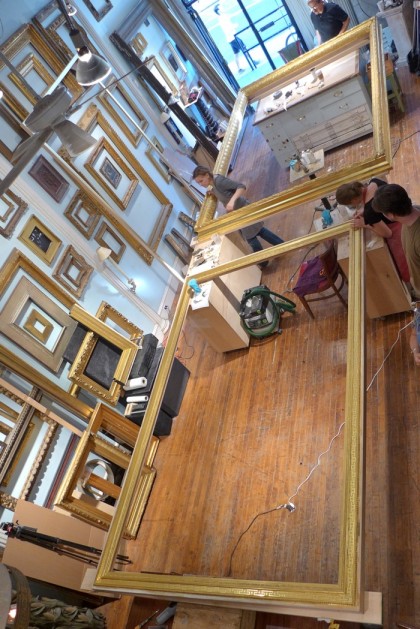
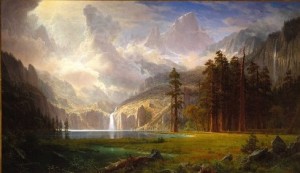 You may have noticed more activity than usual at Gill & Lagodich Fine Period Frames & Restoration on Reade. “We’re fabricating a frame for the Rockwell Museum of Western Art in Corning, New York,” emailed Tracy Gill last week. “It’s the biggest replica, both in size and complexity, that we’ve made from scratch.” It’s so large—eight feet by twelve feet, with each side almost a foot wide—that they had to build it in the main showroom instead of downstairs or in their studio on Duane.
You may have noticed more activity than usual at Gill & Lagodich Fine Period Frames & Restoration on Reade. “We’re fabricating a frame for the Rockwell Museum of Western Art in Corning, New York,” emailed Tracy Gill last week. “It’s the biggest replica, both in size and complexity, that we’ve made from scratch.” It’s so large—eight feet by twelve feet, with each side almost a foot wide—that they had to build it in the main showroom instead of downstairs or in their studio on Duane.
The frame is for Albert Bierstadt’s “Mount Whitney” (1877), a cornerstone of the Rockwell Museum’s collection. “‘Mt. Whitney’ harks back to the day when American painters of grand scenery sent their paintings on tour, in frames designed to create a stage-like appearance,” explained Tracy when I stopped by. “People would pay to view the painting.”
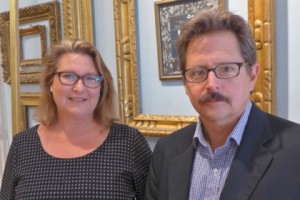 And when you need a historically accurate, impeccably made or restored frame, you turn to Tracy Gill and her husband, Simeon Lagodich. They started the business in their loft on Duane, opening the Reade space in 1996. (Lower Manhattan was where many gilders and frame makers plied their trades: “There was a gilder/framer named Lawrence Van Buskirk at our exact Reade Street address from 1832 to 1835!” said Tracy.) Gill & Lagodich currently has over a thousand frames in its inventory, ranging from the 1500s to contemporary, worth anything from a couple hundred bucks to over a hundred grand. “The historical frames can be replicated for certain projects or we’ll resize and restore them to suit many kinds of art, photography and mirrors,” said Tracy. The frames only get restored once they’re set to be purchased—and anyway, many patrons prefer frames that aren’t restored or gilded (which Tracy calls “noble rot”).
And when you need a historically accurate, impeccably made or restored frame, you turn to Tracy Gill and her husband, Simeon Lagodich. They started the business in their loft on Duane, opening the Reade space in 1996. (Lower Manhattan was where many gilders and frame makers plied their trades: “There was a gilder/framer named Lawrence Van Buskirk at our exact Reade Street address from 1832 to 1835!” said Tracy.) Gill & Lagodich currently has over a thousand frames in its inventory, ranging from the 1500s to contemporary, worth anything from a couple hundred bucks to over a hundred grand. “The historical frames can be replicated for certain projects or we’ll resize and restore them to suit many kinds of art, photography and mirrors,” said Tracy. The frames only get restored once they’re set to be purchased—and anyway, many patrons prefer frames that aren’t restored or gilded (which Tracy calls “noble rot”).
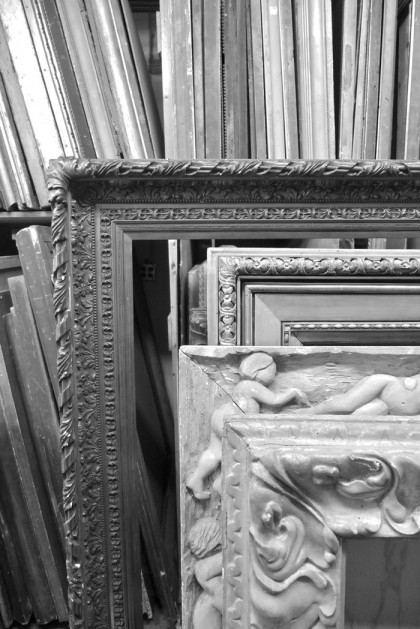 All those frames also serve as a library that the G&L team can reference when creating a new frame. The “Mount Whitney” frame, for instance, incorporates various period-appropriate design elements, as sourced from the frames in inventory. The goal is to come up with something that might have been designed in the late 19th century, without directly copying an existing frame.
All those frames also serve as a library that the G&L team can reference when creating a new frame. The “Mount Whitney” frame, for instance, incorporates various period-appropriate design elements, as sourced from the frames in inventory. The goal is to come up with something that might have been designed in the late 19th century, without directly copying an existing frame.
Now, here’s Tracy’s account of the Bierstadt frame, from start to finish.
A custom milled wood substrate required twelve custom-designed knives for milling.
Once the wood substrate was completed, each length was gessoed. Gesso must be applied at a constant temperature or it will not go on smoothly. This is no mean feat on such long pieces of molding. Each length then has to be sanded perfectly smooth by hand or the microscopically thin gold leaf applied over it will look bumpy.
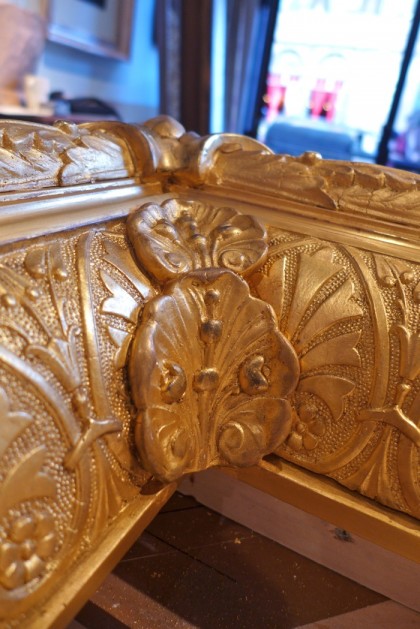 And then the ornament. Nine different ornament patterns: cast of plaster and traditional composition (a mixture of chalk, linseed oil, rosin, and hide glue that is steamed and pressed into rigid molds). Simeon and his studio experts hand-mixed the composition, steamed it and pressed it into molds, and then glued each component part of ornament on the wood.
And then the ornament. Nine different ornament patterns: cast of plaster and traditional composition (a mixture of chalk, linseed oil, rosin, and hide glue that is steamed and pressed into rigid molds). Simeon and his studio experts hand-mixed the composition, steamed it and pressed it into molds, and then glued each component part of ornament on the wood.
The Bierstadt frame has nine different ornaments in varying sizes and lengths, including several different corner motifs. If all the ornament we fabricated were laid out flat end to end, that’s nearly a football field of ornament! (Though we fabricated many more lengths and just picked the best, we ultimately used about 89 yards for six types of ornament in lengths, and a total of nine different patterns, including the hand-incised frieze.)
After the ornament is placed, traditional layers of gesso and colored bole (gilder’s clay mixed with rabbit skin glue) are painted on at a constant temperature and smoothed to prepare the layer for gilding.
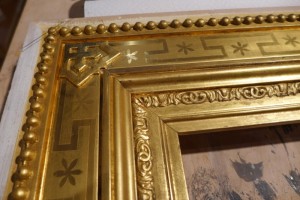 The flat gilded frieze is hand-incised with burnished details in a running fret and flower pattern. That’s actual drawing with a stylus into the gilded surface by hand, after the frame is gilded.
The flat gilded frieze is hand-incised with burnished details in a running fret and flower pattern. That’s actual drawing with a stylus into the gilded surface by hand, after the frame is gilded.
And what about the gold? We are using genuine gold leaf, with traditional application methods of both water gilding and oil gilding. Each square of gold leaf measures just 3-3/8 inches, so picture how many inches of gold we will need to cover this entire frame—eight by twelve feet by 11-1/4 inches. And that’s not flat. There are myriad nooks and crannies and shapes of ornament that need to be covered with gold. And gold leaf is so thin, many areas will need to be double-gilded to give solid coverage. We’re looking at close to 200 square feet of gold leaf!
After all that, the frame is patinated—toned and distressed to make it look 150 years old.
Final touch-ups will be done on Monday when the frame will be packed for shipping out Tuesday morning to begin its trip upstate.
“Our next big project is another monumental frame,” said Tracy. “It’s going to the Seattle Art Museum. But that’s another artist and another story.”
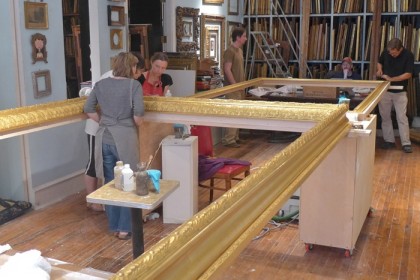
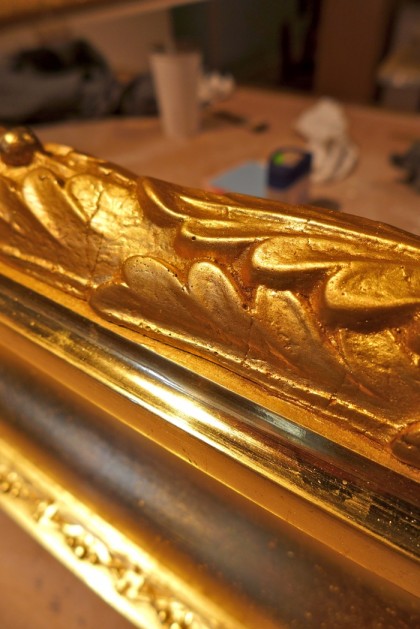
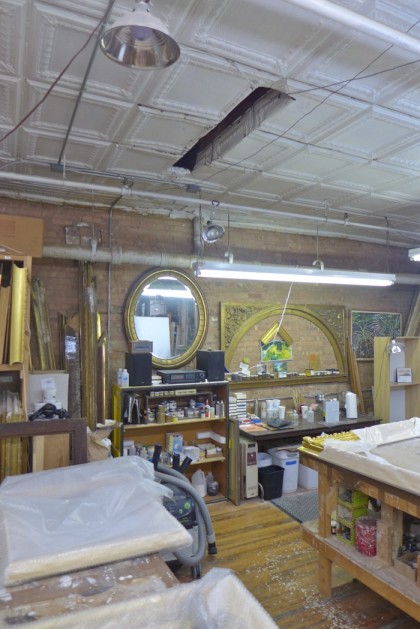 (The slit in the lower-level’s ceiling is so frames can be easily passed up to the street level.)
(The slit in the lower-level’s ceiling is so frames can be easily passed up to the street level.)
Previous Made in Tribeca articles:
• Let There Be Neon
• Best Made Co.
• Khushi













We are pleased to report that the frame was trucked up to Corning New York yesterday, craned up to the third floor of the museum just after dawn this morning, and married to the painting this afternoon. It looks stupendous!
Thanks to all who contributed, and thanks so much to Erik for the wonderful write up! (Gill & Lagodich and the Rockwell Museum of Western Art are posting images of the final event on our Facebook pages. Please visit if you are interested. https://www.facebook.com/photo.php?fbid=741535839195120&set=pcb.741535982528439&type=1&theater )
Images also on Gill & Lagodich Facebook page
https://www.facebook.com/photo.php?fbid=639768312724140&set=a.196427820391527.47588.163612427006400&type=1&theater
Thanks for posting this story. It is good to know that something (other than money) is still being made in TriBeCa.